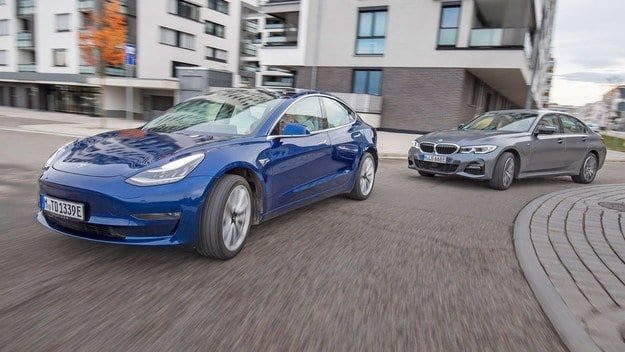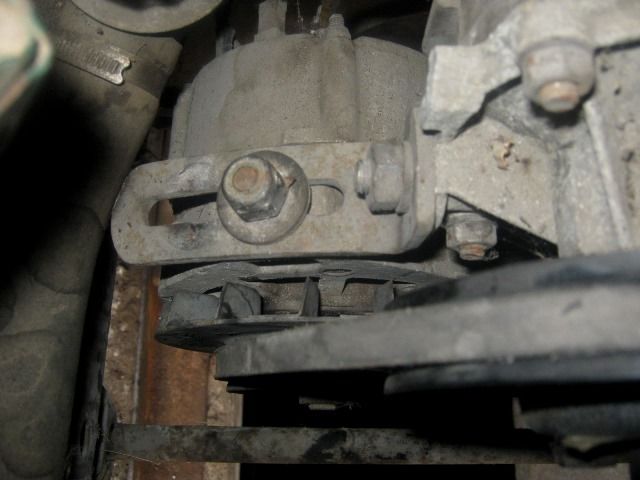
Test drive BMW 330e and Tesla Model 3: Three for three

A somewhat unusual test of two different concepts related to electricity
We have repeatedly compared cars to diesel or gasoline engines in search of the advantages of each of the units. Outside of standard comparison tests between models with similar characteristics and engines of the same type. This time we will approach in a new way, but not unexpectedly. We will compare the pure electric and plug-in hybrid models in terms of ride and handling.
With the BMW, the 330e moves along the highway in a northerly direction at a speed of 160 km/h. The surface of the area, which was once used for military purposes, has cracks, but the chassis of the hybrid “three” transmits a negligible part of the bumps to passengers. This is true for both short shallow joints and large waves. The 330e's complex kinematic suspension ensures both passenger comfort and precise cornering via adaptive dampers. Having them is definitely an important feature given the 18-inch tires and the car's hefty 1832kg weight. However, the chassis behavior is clean, with a distinctive direct connection and precisely filtered transmission of information from the road.
Serious table in itself
The behavior of the drive does not lag behind the accuracy of the specified components. The eight-speed automatic transmission ensures perfect synchronization of the engine and the torque converter motor with 83 kW (in other words, 113 hp), delivering 265 Nm of torque. The maximum power for the machine's energy recovery is 20 kW, which the power electronics sends to a lithium-ion battery with a total capacity of 12 kWh. The latter is located in the space above the rear axle and under the trunk, as a result of which its volume has been reduced from 480 to 375 liters. This disadvantage is to some extent compensated for by good maneuverability and folding in a 40:20:40 ratio of the rear seat.
Up to 110 km / h in hybrid mode, the electric motor can take over control of the drive, and in pure electric mode, this speed increases to 140 km / h. From here, or in the event of a sudden demand for power, the four-cylinder internal combustion engine is included in the equation (of course, much more often in hybrid mode). The gasoline turbo engine itself develops a power of 184 hp. and with a torque of 300 Nm at 1350 rpm. Thus, the combination of the two machines provides a combined power and torque of 252 hp. and 420 Nm. In the so-called XtraBoost mode (sport mode) or kickdown, the maximum power can reach 292 hp. for a short time.
The latter sounds much more impressive than it actually is. The key word here is “weight”. While a 6,1 second 100-3 km/h sprint is quite impressive, subjectively it doesn't look as dramatic as the Tesla Model 330 due to the latter's direct nature of purely electric drive. Despite the accuracy of the transmission, the XNUMXe takes longer to activate and synchronize all of its components.
In the background, the soundscape includes the not-so-inspiring sound of a four-cylinder unit, but that's only true when it comes to the acceleration in question. With uniform driving on the highway, it fades into the background as part of the overall harmonious composition of the car with the mentioned chassis and steering. Added to this are perfectly shaped seats that form the fusion of a beautifully configured sedan from the premium mid-range segment. You are surrounded by quality materials and perfectly assembled parts - you really have to look closely to find something under your feet that betrays the search for a way to reduce the cost of materials. The remote-controlled cruise control works reliably and registers early stopping of vehicles, while the traffic sign recognition system works with the maximum possible reading of 95 percent. And the Harman audio system easily finds its place in this abundance of luxury; only some of the infotainment system's online features leave something to be desired.
The other side of the weight
However, the music takes on a completely different dimension when you enter the interior of the Tesla. In this respect, the model demonstrates something typical of electric vehicles in general. Firstly, it's impressive, firstly because the Tesla soon becomes noisier than the BMW, and secondly because the explosive power takes over your mind shortly after launch. And that's it - although the tested model is in the base version, with normal mileage Standard Plus and is powered by just one 190kW (258hp) (synchronous) motor and torque from a whopping 525Nm available at zero. revolution. Jehovah.
Prejudices about the weight of electric vehicles can be set aside, because at 1622 kg the Model 3 is much lighter than the 330e. It takes 5,9 seconds for an American car to reach 100 km/h, 160 km/h can also be easily maintained, and if conditions permit, much higher values are possible. However, maintaining the latter is accompanied by a noticeable and rapid decrease in the battery charge level with a maximum capacity of 55 kWh. As a battery specialist, Tesla is aiming to reduce the amount of rare metals - with an average cobalt level of 8 percent, it is only 2,8 percent in the batteries used by the company. By the way, BMW says that their next generation electric motors (from 2021) will not use rare metals.
Here and now, the 330e boasts 20 percent less CO2 emissions than the 330i, taking into account the entire energy production cycle. And when using electricity from renewable sources, this value increases even more.
Naturally, the radiation equation in this case also improves with Tesla. It takes 100 hours to charge a large battery from zero to 12 percent of a standard home network, but this information, by the way, does not directly affect the test. Here we are not focusing on the charging capabilities or the time it takes to do so, as we usually do with hybrid or electric vehicles.
On the other hand, we focus on parameters such as total mileage and fuel / energy consumption. Tesla has the latter at 17,1 kWh, which provides the car with a range of 326 km. The 330e achieves double the total range, with a net electric drive share of around 54 km. However, even if the total mileage was the same, this would not be a problem, because a car can fill its tank with gas in a few minutes. The Model 3 opposes driver pleasure to this trump.
Guardian angels in fasting
On the road, the electric model shows off its slightly skittish character with a rather firm suspension – thanks in part to the large 19-inch tires (optional). The stability of the steering wheel in the middle position is not up to par, the accuracy of the feedback is also not ideal, and even when driving straight, the car requires more concentration than the Bavarian "troika".
This may require more reliance on a tape recorder or an autopilot assistant. But the first one works quite capriciously, and the second one is quite vigorous, but not accurate. I think it's best to rely on your own driving skills. Shortly after leaving the highway and driving on roads with a lot of curves, the Model 3 opens up other possibilities. Turns are the key word. Brakes, crooked maintenance. Tesla makes you feel confident by giving more and more "gas". But this is crazy! Come on, maybe more! In those rare moments when you have a chance to look at the centrally located tablet, which displays all the available information, you see that the control signal is activated to activate the control electronics.
But this is really in extreme situations. In practice, the Model 3 distributes power to the wheels very quickly and accurately. Even when ESP is activated, it does so in a very sensitive way. This is facilitated by the direct transmission of torque from the electric motor to the rear axle and the possibility of its precise control.
Despite the precise architecture of the chassis in these cases, the driver of the Bavarian "troika" must remain much more tense in order to be able to follow the American car. Unlike the Model 3 and regular 3 Series versions, the hybrid Bavarian does not have such good weight distribution and is dominated by tables on the rear axle. This, in turn, becomes a problem for the driver, who must curb the tendency of the lighter front axle to not hold position in corners - in large part due to more serious body lean.
On the other hand, the ability to quickly dampen body vibrations speaks for itself in dynamic performance tests. The 330e's sophisticated and efficient suspension design and balance of dynamic weight transfer keeps you on a high level of traction and good rhythm in tests like the 18m slalom and dual lane change. For its part, Tesla first understeers and then wobbles the rear, which in turn causes panic on the part of the regulating electronics. But we repeat - this applies to the results of extreme tests, otherwise on the road in real conditions, the behavior is commendable.
So the Model 3 grabs you again and quickly corners you. Maintains neutral behavior for a long time in a corner before slightly understeer starts. Changing the load when moving from the limit mode leads to a slight swinging of the rear, but this is easily controlled by electronics. In the car, you sit closer to the central axis, and the ergonomics of the seat allow you to focus on driving without being distracted by anything else. Unfortunately, and from nothing significant. All information and function control (except wipers and turn signals) is organized on one tablet - also, unfortunately, without the peak of ergonomics due to a not very effective voice command.
It's unclear what motivation to cut costs led Tesla to make such ergonomic decisions. And also why it was necessary to save on insulation - aerodynamic noise from the driver's door exceeds that of some convertibles, mind you, with an open roof. And the lack of paintwork on parts of the surfaces can be seen without removing the cladding.
Yes, the Tesla is starting to make more and more friends and enjoy driving, but the BMW is a great car. And much more accurately assembled.
CONCLUSION
1. BMW
The conclusion is clear: the car is better. What for? More comfortable suspension, very good seats, reliable support systems. Too hard to ride with pleasure.
2. tesla
The unequivocal conclusion: the funniest car to drive. Delights the driver with dynamic handling, high levels of safety and electric emissions. Unfortunately, the workmanship is poor.
text:
Jens Drale
a photo: Tyson Jopson
